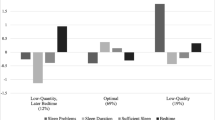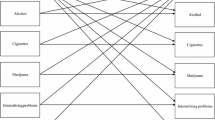Abstract
Despite the known deficits in sleep that occur during adolescence and the high prevalence of substance use behaviors among this group, relatively little research has explored how sleep and substance use may be causally related. The purpose of this study was to explore the longitudinal bi-directional relationships between sleep duration, sleep patterns and youth substance use behaviors. Participants included 704 mostly white (86.4 %) youth, 51 % female, with a baseline mean age of 14.7 years. Self-reported substance use behaviors included past month alcohol, cigarette, and marijuana use. Sleep measures included sleep duration on weekends and weekdays, total sleep, weekend oversleep, and weekend sleep delay. Cross-lagged structural equation models, accounting for clustering at the school level, were run to determine the longitudinal association between sleep and substance use adjusting for socio-demographic characteristics, pubertal status, body mass index z-score, and depressive symptoms. Cigarette use and weekend sleep were bi-directionally related as were marijuana use and total sleep. No other bi-directional associations were identified. However, alcohol use predicted shorter weekend oversleep and marijuana use predicted increased weekend sleep and weekend oversleep. Sleep patterns and duration also predicted adolescents’ cigarette, alcohol, and marijuana use. Sleep, both patterns and duration, and substance use among youth are intertwined. Future research is needed to explore these bi-directional relationships, as well as other important contextual factors that may moderate these associations.

Similar content being viewed by others
References
Bollen, K. A., & Curran, P. J. (2006). Latent curve models : a structural equation perspective (Wiley series in probability and statistics). Hoboken, N.J.: Wiley-Interscience.
Cappuccio, F. P., Taggart, F. M., Kandala, N. B., Currie, A., Peile, E., Stranges, S., et al. (2008). Meta-analysis of short sleep duration and obesity in children and adults. Sleep, 31(5), 619–626.
Carskadon, M. A., Harvey, K., & Dement, W. C. (1981). Acute restriction of nocturnal sleep in children. Perception and Motor Skills, 53, 103–112.
Carskadon, M. A., Vieira, C., & Acebo, C. (1993). Association between puberty and delayed phase preference. Sleep, 16(3), 258–262.
Carskadon, M. A., Wolfson, A. R., Acebo, C., Tzischinsky, O., & Seifer, R. (1998). Adolescent sleep patterns, circadian timing, and sleepiness at a transition to early school days. Sleep, 21(8), 871–881.
Centers for Disease Control and Prevention. (2012). Youth risk behavior surveillance—United States, 2011. Morbidity and Mortality Weekly Report, 61(4), 1–166.
Crum, R. M., Storr, C. L., Chan, Y. F., & Ford, D. E. (2004). Sleep disturbance and risk for alcohol-related problems. The American Journal of Psychiatry, 161(7), 1197–1203.
Dahl, R. E. (1996). The impact of inadequate sleep on children’s daytime cognitive function. Seminars in Pediatric Neurology, 3(1), 44–50.
Dahl, R. E., & Lewin, D. S. (2002). Pathways to adolescent health: Sleep regulation and behavior. Journal of Adolescent Health, 31, 175–184.
Eaton, D. K., Kann, L., Kinchen, S., Shanklin, S., Ross, J., Hawkins, J., et al. (2010). Youth risk behavior surveillance—United States, 2009. MMWR. Surveillance summaries: Morbidity and mortality weekly report. Surveillance summaries/CDC, 59(5), 1–142.
Fischer, F. M., Nagai, R., & Teixeira, L. R. (2008). Explaining sleep duration in adolescents: the impact of socio-demographic and lifestyle factors and working status. Chronobiology International, 25(2), 359–372.
Fredriksen, K., Rhodes, J., Reddy, R., & Way, N. (2004). Sleepless in Chicago: Tracking the effects of adolescent sleep loss during the middle school years. Child Development, 75(1), 84–95.
Gluck, M., Geliebter, A., & Satov, T. (2001). Night eating syndrome is associated with depression, low self-esteem, reduced daytime hunger, and less weight loss in obese outpatients. Obesity Research, 9, 264–267.
Goodman, E., & Huang, B. (2002). Socioeconomic status, depressive symptoms, and adolescent substance use. Archives of Pediatrics and Adolescent Medicine, 156(5), 448–453.
Guo, J., Hawkins, J. D., Hill, K. G., & Abbott, R. D. (2001). Childhood and adolescent predictors of alcohol abuse and dependence in young adulthood. Journal of Studies on Alcohol, 62(6), 754–762.
Hallfors, D. D., Waller, M. W., Bauer, D., Ford, C. A., & Halpern, C. T. (2005). Which comes first in adolescence—Sex and drugs or depression? American Journal of Preventive Medicine, 29(3), 163–170.
Hasler, B. P., Smith, L. J., Cousins, J. C., & Bootzin, R. R. (2012). Circadian rhythms, sleep, and substance abuse. Sleep Medicine Reviews, 16(1), 67–81.
Hu, L. T., & Bentler, P. M. (1999). Cutoff criteria for fit indices in covariance structure analysis: Conventional criteria versus new alternatives. Structural Equation Modeling, 6, 1–55.
Johnson, E. O., & Breslau, N. (2001). Sleep problems and substance use in adolescence. Drug and Alcohol Dependence, 64(1), 1–7.
Johnston, L. D., O’Malley, P. M., & Bachman, J. G. (1998). National survey results on drug use from the monitoring the future study, 1975–1997.
Kandel, D., & Davies, M. (1982). Epidemiology of depressive mood in adolescents. Archives of General Psychiatry, 39, 1205–1212.
Kuczmarski, R. J., Ogden, C. L., Guo S. S., et al. (2002). 2000 CDC growth charts for the United States: Methods and development. Vital and Health Statistics, 11(246), 1–203.
Laberge, L., Petit, D., Simard, C., Vitaro, F., & Tremblay, R. E. (2001). Development of sleep patterns in early adolescence. Journal of Sleep Research, 10, 59–67.
Lee, K. A., McEnany, G., & Weekes, D. (1999). Gender differences in sleep patterns for early adolescents. Journal of Adolescent Health, 24, 16–20.
Lytle, L. A. (2009). Examining the etiology of childhood obesity: The IDEA study. American Journal of Community Psychology, 44(3–4), 338–349.
Lytle, L. A., Pasch, K. E., & Farbakhsh, K. (2011). The relationship between sleep and weight in a sample of adolescents. Obesity, 19(2), 324–331.
Muthén, L. K., & Muthén, B. O. (1998–2010). Mplus User’s Guide. (6th Ed.). Los Angeles, CA: Muthén & Muthén.
National Sleep Foundation. (2006). Sleep in America Poll. Washington, D.C.: National Sleep Foundation.
O’Brien, E. M., & Mindell, J. A. (2005). Sleep and risk-taking behavior in adolescents. Behavioral Sleep Medicine, 3(3), 113–133.
Pasch, K. E., Laska, M. N., Lytle, L. A., & Moe, S. G. (2010). Adolescent sleep, risk behaviors, and depressive symptoms: Are they linked? American Journal of Health Behavior, 34(2), 237–248.
Pasch, K. E., Nelson, M. C., Lytle, L. A., Moe, S. G., & Perry, C. L. (2008). Adoption of risk-related factors through early adolescence: Associations with weight status and implications for causal mechanisms. The Journal of Adolescent Health, 43(4), 387–393.
Pasch, K. E., Velazquez, C. E., Cance, J. D., Moe, S. G., & Lytle, L. A. (2012). Youth substance use and body composition: Does risk in one area predict risk in the other? Journal of Youth and Adolescence, 41(1), 14–26.
Patel, S. R., & Hu, F. B. (2008). Short sleep duration and weight gain: A systematic review. Obesity (Silver Spring), 16(3), 643–653.
Patel, S. R., Malhotra, A., White, D. P., Gottlieb, D. J., & Hu, F. B. (2006). Association between reduced sleep and weight gain in women. American Journal of Epidemiology, 164(10), 947–954.
Patton, G. C., & Viner, R. (2007). Pubertal transitions in health. Lancet, 369(9567), 1130–1139.
Petersen, A. C., Crockett, L. J., Richards, M., & Boxer, A. (1988). A self-report measure of pubertal status: Reliability, validity and initial norms. Journal of Youth and Adolescence, 17(2), 117.
Phillips, B. A., & Danner, F. J. (1995). Cigarette smoking and sleep disturbance. Archives of Internal Medicine, 155(7), 734–737.
Roberts, R. E., Roberts, C. R., & Chen, I. G. (2002). Impact of insomnia on future functioning of adolescents. Journal of Psychosomatic Research, 53(1), 561–569.
Roberts, R. E., Roberts, C. R., & Duong, H. T. (2009). Sleepless in adolescence: Prospective data on sleep deprivation, health and functioning. Journal of Adolescence, 32(5), 1045–1057.
Roehrs, T., & Roth, T. (2001). Sleep, sleepiness, and alcohol use. Alcohol Research & Health, 25(2), 101–109.
Sadeh, A., Dahl, R. E., Shahar, G., & Rosenblat-Stein, S. (2009). Sleep and the transition to adolescence: A longitudinal study. Sleep, 32(12), 1602–1609.
Sadeh, A., Gruber, R., & Raviv, A. (2002). Sleep, neurobehavioral functioning, and behavior problems in school-age children. Child Development, 73(2), 405–417.
Shih, R. A., Miles, J. N., Tucker, J. S., Zhou, A. J., & D’Amico, E. J. (2010). Racial/ethnic differences in adolescent substance use: mediation by individual, family, and school factors. Journal of Studies on Alcohol and Drugs, 71(5), 640–651.
Strauch, I., & Meier, B. (1988). Sleep need in adolescents: A longitudinal approach. Sleep, 11(4), 378–386.
Szymczak, J. T., Jasinska, M., Pawlak, E., & Zwierzykowska, M. (1993). Annual and weekly changes in the sleep-wake rhythm of school children. Sleep, 16(5), 433–435.
Townsend, J., Wilkes, H., Haines, A., & Jarvis, M. (1991). Adolescent smokers seen in general practice: health, lifestyle, physical measurements, and response to antismoking advice. British Medical Journal, 303(6808), 947–950.
Tynjala, J., Kannas, L., & Levalahti, E. (1997). Perceived tiredness among adolescents and its association with sleep habits and use of psychoactive substances. Journal of Sleep Research, 6(3), 189–198.
Vignau, J., Bailly, D., Duhamel, A., Vervaecke, P., Beuscart, R., & Collinet, C. (1997). Epidemiologic study of sleep quality and troubles in French secondary school adolescents. Journal of Adolescent Health, 21(5), 343–350.
Wetter, D. W., & Young, T. B. (1994). The relation between cigarette-smoking and sleep disturbance. Preventive Medicine, 23(3), 328–334.
Widome, R., Forster, J. L., Hannan, P. J., & Perry, C. L. (2007). Longitudinal patterns of youth access to cigarettes and smoking progression: Minnesota Adolescent Community Cohort (MACC) study (2000–2003). Preventive Medicine, 45(6), 442–446.
Wills, T. A., Cleary, S., Filer, M., Shinar, O., Mariani, J., & Spera, K. (2001). Temperament related to early-onset substance use: test of a developmental model. Prevention Science, 2(3), 145–163.
Wolfson, A. R. (1996). Sleeping patterns of children and adolescents: Developmental trends, disruptions, and adaptations. Child and Adolescent Psychiatric Clinics of North America, 5(3), 549–568.
Wolfson, A. R., & Carskadon, M. A. (1998). Sleep schedules and daytime functioning in adolescents. Child Development, 69(4), 875–887.
Wolfson, A. R., Carskadon, M. A., Acebo, C., Seifer, R., Fallone, G., Labyak, S. E., et al. (2003). Evidence for the validity of a sleep habits survey for adolescents. Sleep, 26(2), 213–216.
Wong, M. M., Brower, K. J., Fitzgerald, H. E., & Zucker, R. A. (2004). Sleep problems in early childhood and early onset of alcohol and other drug use in adolescence. Alcoholism, Clinical and Experimental Research, 28(4), 578–587.
Wong, M. M., Brower, K. J., Nigg, J. T., & Zucker, R. A. (2010). Childhood sleep problems, response inhibition, and alcohol and drug outcomes in adolescence and young adulthood. Alcoholism, Clinical and Experimental Research, 34(6), 1033–1044.
Wong, M. M., Brower, K. J., & Zucker, R. A. (2009). Childhood sleep problems, early onset of substance use and behavioral problems in adolescence. Sleep Medicine, 10(7), 787–796.
Acknowledgments
This research was funded through a grant from the National Cancer Institute as part of their Transdisciplinary Research in Energetics and Cancer (TREC) Initiative. Grant # 1U54CA116849 and through a grant supported by the Etiology of Childhood Obesity (ECHO) with funding from the National Heart, Lung and Blood Institute, Grant #R01HL085978. The content of this manuscript is solely the responsibility of the authors and does not necessarily represent the official views of the National Cancer Institute, National Heart, Lung and Blood Institute, or the National Institutes of Health.
Author information
Authors and Affiliations
Corresponding author
Rights and permissions
About this article
Cite this article
Pasch, K.E., Latimer, L.A., Cance, J.D. et al. Longitudinal Bi-directional Relationships Between Sleep and Youth Substance Use. J Youth Adolescence 41, 1184–1196 (2012). https://doi.org/10.1007/s10964-012-9784-5
Received:
Accepted:
Published:
Issue Date:
DOI: https://doi.org/10.1007/s10964-012-9784-5




